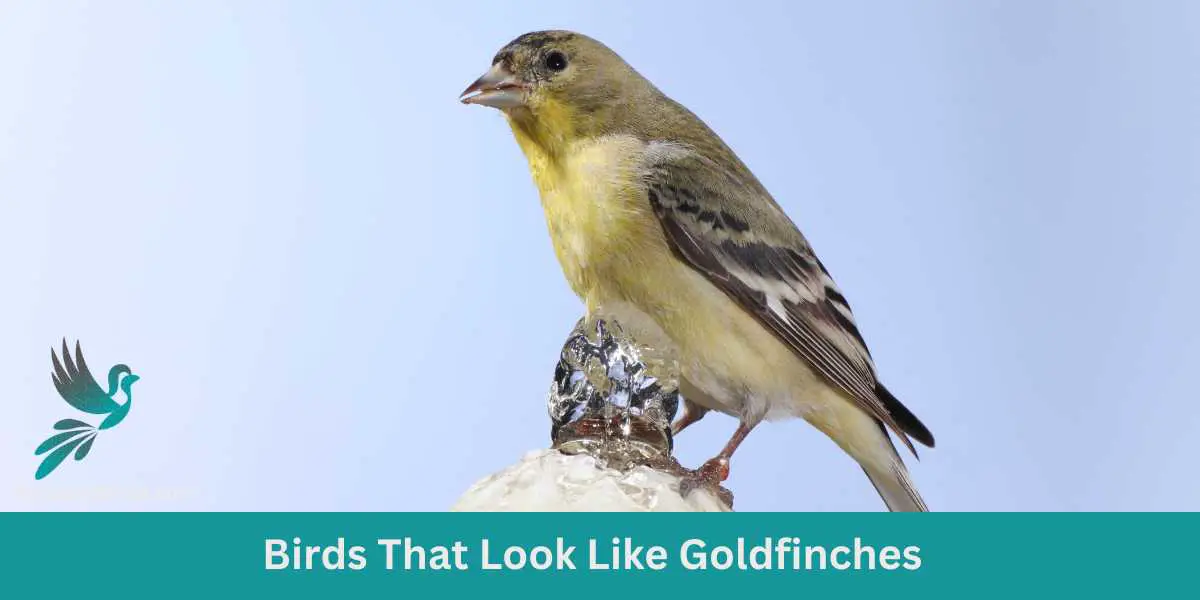Goldfinches, with their striking yellow plumage, are one of nature’s most vibrant birds, instantly recognizable and a favorite among birdwatchers. But the avian world is full of mimicry and similarities – a multitude of species share the Goldfinch’s yellow brilliance.
We’ll take flight and explore 13 bird species that bear a striking resemblance to Goldfinches, diving into their unique characteristics and habitats.
American Goldfinch


| Feature | Measurement |
|---|---|
| Scientific Name | Spinus tristis |
| Length | 4.3-5.5 in |
| Wingspan | 7.5-8.7 in |
| Weight | 11-20 g |
The American Goldfinch (Spinus tristis) is a small North American bird of the finch family. These small birds with bright yellow feathers, also known as the Eastern Goldfinch and Wild Canary, is the state bird of Iowa, New Jersey, and Washington. Adult males are vibrant yellow with black wings, a black forehead, and white underparts and rump. Females are duller, with olive-brown on the upper parts and a pale yellow underneath. Both sexes exhibit pointed beaks, perfect for their diet.
American Goldfinches are largely granivorous, feeding on seeds from dandelions, sunflowers, ragweed, and other plants but they also eat insects. Unlike many other species, they breed later in the summer to coincide with the peak abundance of seeds. Their habitats include weedy fields, meadows, open floodplains, and gardens. Notably, these birds breed in loose colonies and their flight is remarkably undulating.
List of Birds That Look Like Goldfinches
Lets explore 13 remarkable species (and not just yellow birds) that bear a striking resemblance to the beloved Goldfinch that might visit bird feeders:
Evening Grosbeaks


| Feature | Measurement |
|---|---|
| Scientific Name | Hesperiphona vespertina |
| Length | 6.3-8.7 in |
| Wingspan | 12-14 in |
| Weight | 38.7-86.1 g |
The Evening Grosbeak (Coccothraustes vespertinus) is a striking, medium-sized finch found across North America. It boasts a robust, short-tailed body with a large head and an even larger bill, ideal for cracking the seeds that form a large part of its diet. Adult males are particularly noticeable with their vibrant yellow bodies, dark wings, and a large pale bill, whereas females and young birds are more subtly colored with grey-brown tones.
Evening Grosbeaks are known for their periodic winter irruptions, where large flocks suddenly appear in areas outside their typical range, primarily in response to food availability. They inhabit both deciduous and coniferous forests and are often seen in treetops, though they are also frequent visitors to bird feeders. Their diet largely consists of seeds and berries, but they also consume insects during the breeding season.
Pine Grosbeak

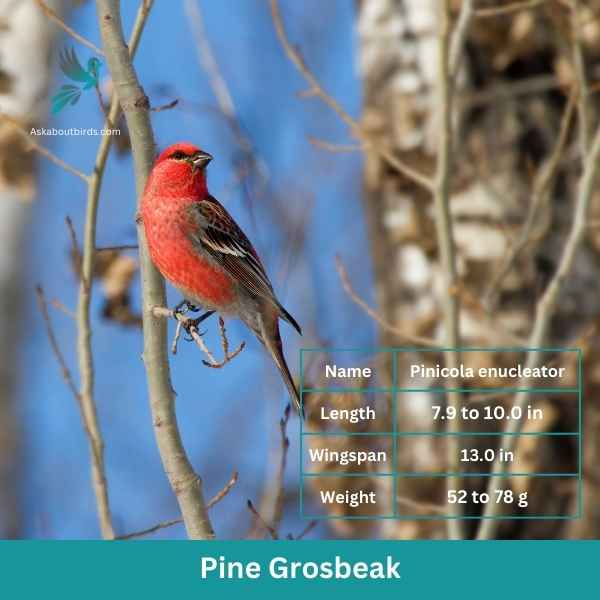
| Feature | Measurement |
|---|---|
| Scientific Name | Pinicola enucleator |
| Length | 7.9 to 10.0 in |
| Wingspan | 13.0 in |
| Weight | 52 to 78 g |
The Pine Grosbeak is a striking bird native to the northern regions of North America, often found in coniferous forests. Both males and females have a plump and robust body with a large beak adapted for eating seeds. The male Pine Grosbeak displays a vibrant reddish-pink plumage, while the female has a more subdued grayish-brown coloration.
These birds are typically seen in small flocks, foraging for food in trees and on the ground. They have a preference for seeds, particularly those from various conifer species. The Pine Grosbeak uses its strong bill to crack open the cones of tall trees and extract the seeds, but they also consume berries and small fruits when available.
Pine Warbler
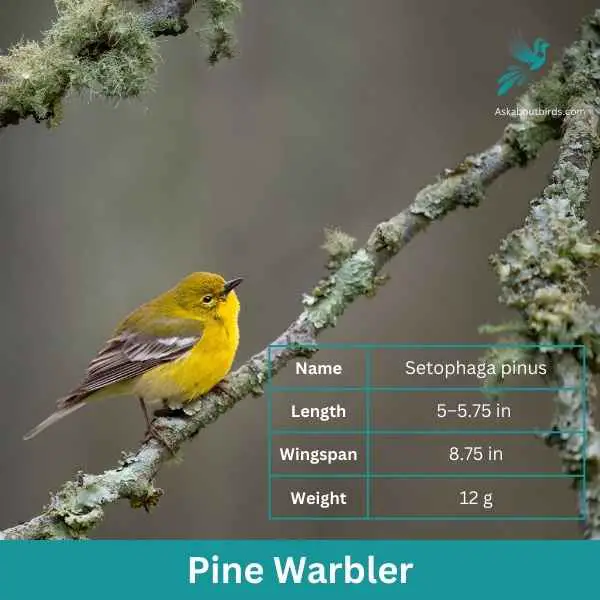

| Feature | Measurement |
|---|---|
| Scientific Name | Setophaga pinus |
| Length | 5–5.75 in |
| Wingspan | 8.75 in |
| Weight | 12 g |
The Pine Warbler (Setophaga pinus) is a small songbird native to North America. Part of the New World warbler family, the Pine Warbler is often found in pine forests, hence its name. Males of the species have bright yellow bellies and olive-gray upperparts, while females and young birds are more muted in color. They all, however, share dark legs and a thin, relatively long bill.
The diet of Pine Warblers is varied, consisting of insects, seeds, and berries, but they show a notable preference for caterpillars and other soft-bodied invertebrates during the breeding season. Unlike most warblers, Pine Warblers also regularly come to bird feeders, particularly in winter, making them a favorite among bird watchers. The Pine Warbler’s song is a musical trill, and they are one of the earliest nesting warblers, often laying eggs in April or early May.
Western Tanager

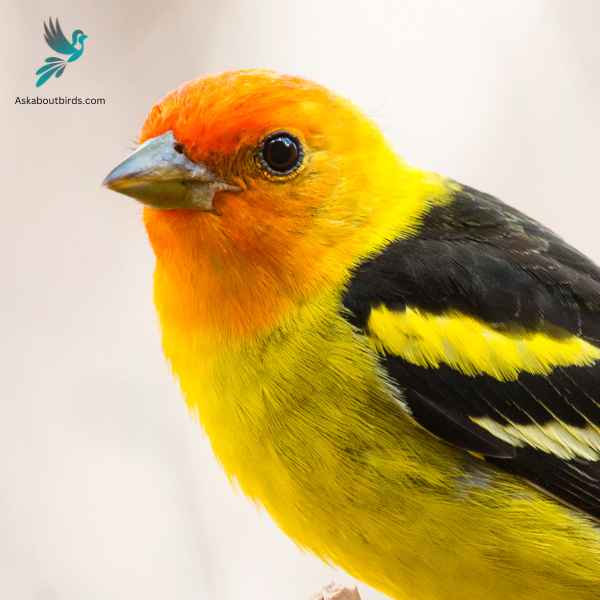
| Feature | Measurement |
|---|---|
| Scientific Name | Piranga ludoviciana |
| Length | 6.3-7.5 in |
| Wingspan | 11.5 in |
| Weight | 24-36 g |
The Western Tanager is a vibrant songbird that graces the forests and woodlands of the western regions of North America, enchanting observers with its colorful plumage and melodious song.
Appearance: The male Western Tanager is renowned for its bright yellow body contrasted with a striking red head and black wings and tail. The females are more subdued in hue, primarily being yellow with grayish wings and back, and lacking the brilliant red head of the males.
Diet: Western Tanagers primarily feed on insects, especially when breeding, but they also incorporate a significant amount of fruits and berries into their diet, especially during migration and winter.
Reproduction: Western Tanagers build their nests high in coniferous trees, often well concealed from potential predators. The female usually lays a clutch of 3 to 5 eggs and takes the primary role in incubation, while both parents are involved in feeding the chicks after they hatch.
Yellow Warbler


| Feature | Measurement |
|---|---|
| Scientific Name | Setophaga petechia |
| Length | 3.9-7.1 in |
| Wingspan | 6.3-8.7 in |
| Weight | 7-25 g |
The Yellow Warbler (Setophaga petechia) is a small, brightly colored songbird found throughout most of North America. Recognizable by its uniform yellow plumage, the male Yellow Warbler is distinguished by its streaked chestnut lines down the belly. Both males and females have rounded heads, medium-sized bills, and a somewhat long, rounded tail, which aids in their distinctive, swift, and direct flight patterns.
Yellow Warblers inhabit a broad range of habitats, including thickets, woods, gardens, and marshes. They are insectivores, feeding primarily on caterpillars, beetles, and other small invertebrates. Yellow Warblers are known for their distinctive song, described as a series of sweet-sounding whistles and repetitive phrases. They are also known for their unique response to the parasitic Brown-headed Cowbird. If a cowbird lays its eggs in the warbler’s nest, the warbler often builds a new floor over the eggs, raising the bottom of the nest and possibly repeating this process if the cowbird continues its parasitic attempts.
Orchard Oriole
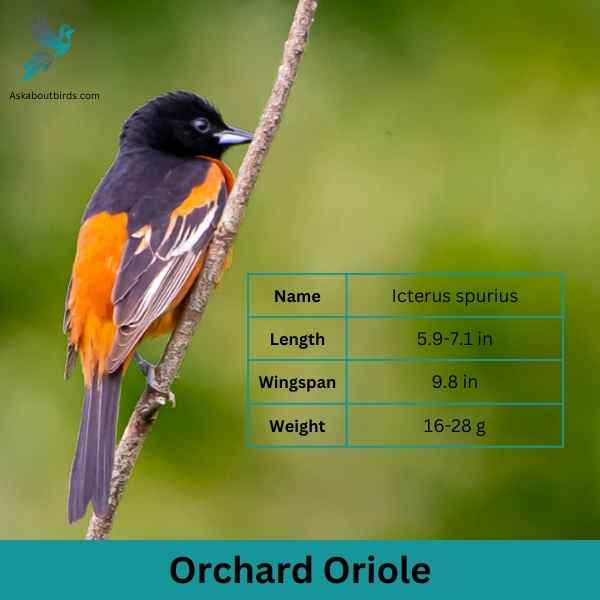
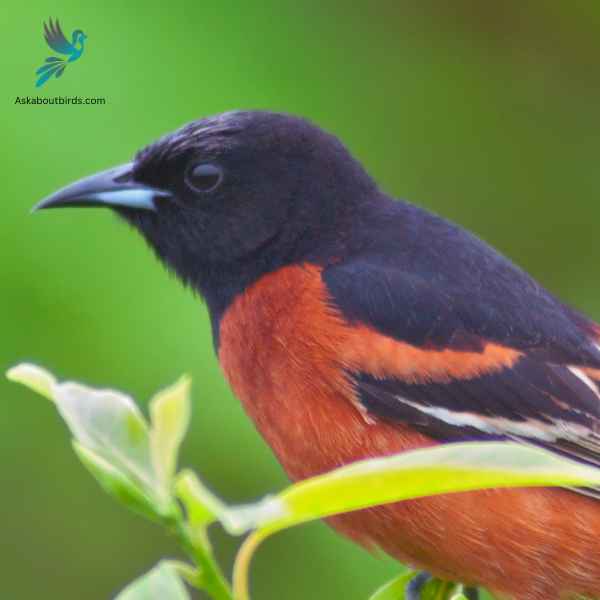
| Feature | Measurement |
|---|---|
| Scientific Name | Icterus spurius |
| Length | 5.9-7.1 in |
| Wingspan | 9.8 in |
| Weight | 16-28 g |
The Orchard Oriole is a small songbird noted for its distinctive coloration and melodic song.
Appearance: Male Orchard Orioles are a striking sight with their dark chestnut body and black head and black and white wings, while females and immature males are olive-green and feature a yellowish underpart. The species is often recognized by its slender body and pointed bill.
Diet: The diet of the Orchard Oriole consists primarily of insects, fruits, and nectar. They are adept at catching insects mid-air and are also known to sip nectar from flowers, aiding in pollination. When fruits are in season, they make up a substantial portion of the bird’s diet.
Reproduction: Orchard Orioles often nest in open woodlands and orchards, hence their name. The female is responsible for building the nest, typically choosing a location in a tree or shrub. The female lays a clutch of 4 to 6 eggs, which she incubates for about two weeks.
Summer Tanager


| Feature | Measurement |
|---|---|
| Scientific Name | Piranga rubra |
| Length | 6.7 in |
| Wingspan | 28 to 30 cm |
| Weight | 29 g |
The Summer Tanager is a medium-sized songbird admired for its radiant plumage and melodious song.
Appearance: Male Summer Tanagers are an impressive bright red, while females and juveniles present a softer, yellow-orange color. Both genders have a large, slightly hooked bill and relatively short tail.
Diet: Summer Tanagers primarily feed on insects, including bees and wasps, which they catch in flight or pick off vegetation. They are also known to eat fruits and berries, making them helpful in controlling pest populations and seed dispersal.
Reproduction: The female Summer Tanager builds a loose, shallow cup-shaped nest out of twigs and grass, usually hidden in the foliage of trees. The female typically lays 3-5 eggs, which she will incubate for about two weeks.
Scarlet Tanager


| Feature | Measurement |
|---|---|
| Scientific Name | Piranga olivacea |
| Length | 6.3 to 7.5 in |
| Wingspan | 9.8 to 11.8 in |
| Weight | 23.5 to 38 g |
The Scarlet Tanager is a strikingly colorful bird known for its brilliant plumage and distinctive song.
Appearance: Male Scarlet Tanagers are notable for their vibrant scarlet bodies contrasted with black wings and tail, making them one of the most intensely colored birds. Females and juveniles, on the other hand, have a subdued olive-yellow body color with darker wings and tail.
Diet: The diet of the Scarlet Tanager is largely made up of insects, including beetles, cicadas, aphids, and others. They are adept flycatchers, seizing insects in mid-air or picking them off foliage. They also consume fruits and berries, especially during migration and in their winter habitats.
Reproduction: The female Scarlet Tanager builds a cup-shaped nest using twigs, rootlets, and grass, typically well-hidden in the dense foliage of trees. She lays 3 to 5 eggs and incubates them for about two weeks.
Yellow-Breasted Chat
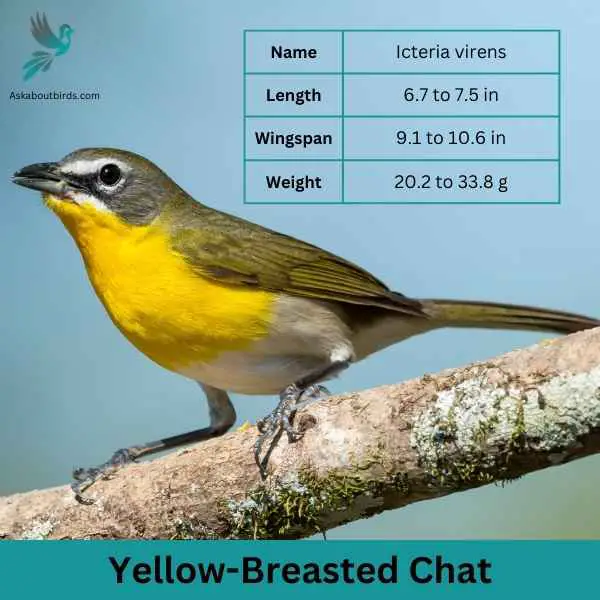

| Feature | Measurement |
|---|---|
| Scientific Name | Icteria virens |
| Length | 6.7 to 7.5 in |
| Wingspan | 9.1 to 10.6 in |
| Weight | 20.2 to 33.8 g |
The Yellow-breasted Chat (Icteria virens) is a large songbird, known for its striking yellow chest and throat, coupled with an olive-green body and white belly. Its name is derived from its loud, varied, and often amusing song, which can include a wide range of notes, mimicked sounds, and even mechanical noises. With their long tail, sturdy bill, and relatively large size, Yellow-breasted Chats are easily distinguishable from other songbirds.
Yellow-breasted Chats prefer dense, shrubby areas including woodland edges, overgrown pastures, and thickets along streams. They are predominantly insectivores, feeding on ants, beetles, and caterpillars, though they also consume a variety of berries and fruits. Their breeding behavior is rather unusual: males are known to perform elaborate displays which include singing, showing off their bright yellow chest, and making mock flights at potential predators.
Common Yellowthroat
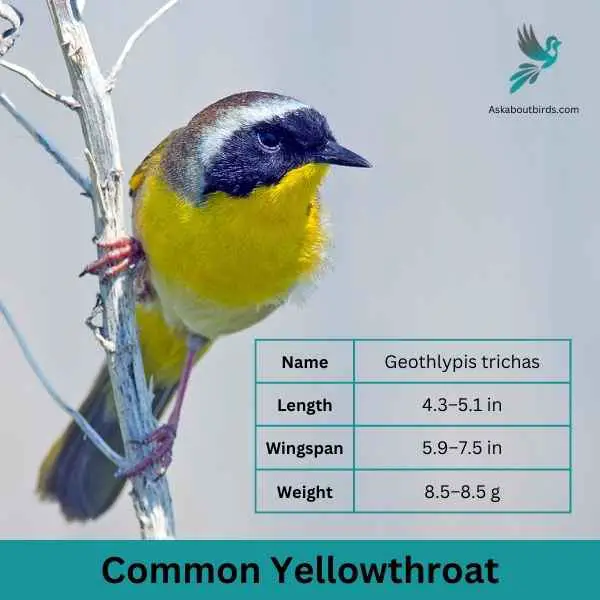

| Feature | Measurement |
|---|---|
| Scientific Name | Geothlypis trichas |
| Length | 4.3–5.1 in |
| Wingspan | 5.9–7.5 in |
| Weight | 8.5–8.5 g |
The Common Yellowthroat (Geothlypis trichas) is a small species of warbler known for the male’s distinct ‘bandit-mask’— a broad black mask across its face contrasted by a bright yellow throat. The rest of its body exhibits olive-brown coloring. Females, however, lack the black mask and are much duller in color, showcasing more of a soft brown overall plumage with a somewhat lighter yellow throat.
Common Yellowthroats inhabit dense vegetation in a variety of habitats including marshes, wetlands, and scrubby fields across North America. They are well known for their distinctive “witchety-witchety-witchety” song. Their diet mainly consists of insects and spiders. During the breeding season, males are territorial and often polygynous, attracting mates by singing from prominent perches. The species faces threats from habitat loss due to wetland drainage and urban development.
Orchard Oriole


| Feature | Measurement |
|---|---|
| Scientific Name | Icterus spurius |
| Length | 5.9-7.1 in |
| Wingspan | 9.8 in |
| Weight | 16-28 g |
The Orchard Oriole is a small songbird noted for its distinctive coloration and melodic song.
Appearance: Male Orchard Orioles are a striking sight with their dark chestnut body and black head and black and white wings, while females and immature males are olive-green and feature a yellowish underpart. The species is often recognized by its slender body and pointed bill.
Diet: The diet of the Orchard Oriole consists primarily of insects, fruits, and nectar. They are adept at catching insects mid-air and are also known to sip nectar from flowers, aiding in pollination. When fruits are in season, they make up a substantial portion of the bird’s diet.
Reproduction: Orchard Orioles often nest in open woodlands and orchards, hence their name. The female is responsible for building the nest, typically choosing a location in a tree or shrub. The female lays a clutch of 4 to 6 eggs, which she incubates for about two weeks.
Pine Siskins


| Feature | Measurement |
|---|---|
| Scientific Name | Spinus pinus |
| Length | 4.3–5.5 in |
| Wingspan | 7.1–8.7 in |
| Weight | 12–18 g |
The Pine Siskin (Spinus pinus) is a small, lively finch known for its streaked plumage and sharply pointed bill. Its overall coloration is brown and white with subtle yellow edgings on the wings and tail, which can become more pronounced during flight. A distinct characteristic of Pine Siskins is their notably slim bodies and long, notched tails, which set them apart from many other finch species.
Native to North America, Pine Siskins are highly adaptable and can be found in a wide variety of habitats, from coniferous and mixed forests to suburban backyards. They are known for their erratic migration patterns, which are driven by the availability of their preferred food – seeds from conifers and other trees, as well as weed seeds and grass. Though they can be somewhat elusive when in their natural habitats, Pine Siskins are known to readily approach bird feeders, especially in winter, offering bird watchers a good viewing opportunity.
Yellow Orioles


| Feature | Measurement |
|---|---|
| Scientific Name | Icterus nigrogularis |
| Length | 7.9–8.3 in |
| Wingspan | — |
| Weight | 38-50 g |
The Yellow Oriole (Icterus nigrogularis), also known as the Yellow-backed Oriole, is a vibrant bird species found in South America. Sporting a stunning yellow plumage with a black throat, lores, and back, the males of this species are easily noticeable, while the females possess a similar color pattern but in more subdued tones. The bird is medium-sized with a long tail and a strong, straight beak which is ideal for foraging.
Yellow Orioles are predominantly found in open woodlands, gallery forests, scrub, and gardens, often near water bodies. They feed on a diet primarily comprised of insects, fruits, and nectar. Breeding typically occurs between March and August, during which the birds construct an elaborate, hanging woven nest using palm and other fibers. These nests are often located in tall trees or near human habitation for protection from predators.
Is there another bird that looks like a goldfinch?
Yes, several birds have similar color patterns and could be mistaken for a Goldfinch. These include the Pine Warbler, Yellow Warbler, and Western Tanager, all of which feature yellow or gold plumage. The Evening Grosbeak and Pine Grosbeak also have some similar features, particularly the males, which exhibit yellow coloration.
What is the small bird that looks like a goldfinch?
The Pine Warbler is a small bird that bears a resemblance to the Goldfinch. It’s known for its olive-yellow upperparts and brighter yellow chest and belly, which may cause it to be mistaken for a Goldfinch. However, it lacks the Goldfinch’s distinctive black and white wing patterns.
What is the difference between a goldfinch and a grosbeak?
While both Goldfinches and Grosbeaks are part of the finch family, they differ in several ways. Goldfinches are smaller, with males sporting vibrant yellow plumage during the summer months, and they primarily eat seeds. Grosbeaks, on the other hand, are larger birds. Males often have bold black, white, and yellow or red coloration. Grosbeaks have a broader diet, consuming insects, seeds, and berries.
What is the difference between yellow finch and yellow Oriole?
“Yellow Finch” is often a colloquial name for the Goldfinch, known for its bright yellow body. Orioles, on the other hand, are a separate group of birds. Yellow Orioles do share the Goldfinch’s love for bright color, but they are generally larger and often feature black markings on the head and back. Orioles also have a more varied diet, including insects, fruit, and nectar, compared to the Goldfinch’s seed-centric diet.
How to attract goldfinches to bird feeders?
Ensure your feeder is stocked with their preferred food, which is primarily Nyjer (thistle) seeds, and to a lesser extent, sunflower seeds. Goldfinches are also drawn to native plants and flowers such as coneflowers, sunflowers, and thistles, which provide natural food sources.

